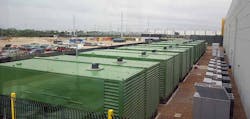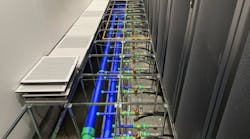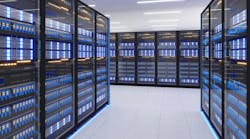Caveat Emptor: Let The Buyer Beware When Buying Renewable Energy
In this week’s Voices of the Industry, Phillip Sandino, Vice President of Data Center Operations at RagingWire Data Centers, examines how data centers can improve their renewable energy usage.
Phillip Sandino, Vice President of Data Center Operations at RagingWire Data Centers
Data center customers want 100% renewable energy. Data center operators would love to offer it. Utilities are eager to deliver it.
But as much as we would love to proclaim a 100% renewables energy world today, we’re not there yet, despite what some confusing headlines say.
For the data center industry, when it comes to renewable energy we need to follow the principle we learned in our Intro to Economics class – caveat emptor or “let the buyer beware.”
Paper Tigers – Renewable Energy Certificates (RECs)
When most data center companies talk about renewable energy usage, they are referring to Renewable Energy Certificates or RECs. A REC is a registered certificate that gives the buyer the marketing rights to claim they used an amount of renewable energy.
RECs can get confusing real fast. Think of it this way. When a renewable energy supplier sells a unit of energy, the price for that energy is divided into two parts: the energy itself + the marketing rights to the unit of energy. For example the unit of energy might cost $X, which is made up of the energy usage costing $.9X and the energy REC costing $.1X. The energy usage and the REC can be purchased separately.
Why go to all this trouble? There is value to the marketing rights of renewable energy. Power utilities can purchase RECs and use them to meet their renewable energy targets. Energy consumers can buy RECs to say they are “using” renewable energy when in fact the energy they buy from the power utility is not renewable.
According to Wikipedia, the first comprehensive system for issuing, registering, trading, and retiring RECs was created by the state of Texas in 2001. Today there are 29 compliance markets in the U.S. being used by energy companies and dozens of voluntary markets used by energy consumers.
RECs are good things, but they are paper not energy. We need to do more.
Onsite Renewables – Challenged by Space and Storage
What’s stopping data center companies from installing renewable energy sources on their sites? The problem is it takes a lot of windmills and solar panels to power a data center. Plus you have the problem of what to do when the wind doesn’t blow or the sun doesn’t shine.
[clickToTweet tweet=”Over the last 5-10 years, data center companies have worked hard to maximize the efficiency of their facilities. ” quote=”Over the last 5-10 years, data center companies have worked hard to maximize the efficiency of their facilities. “]
You may have read how companies like Amazon, Google, and Apple are buying large tracts of land to build their data centers and install renewable energy farms. For example, Apple has a 14MW solar farm on its data center site in Maiden, North Carolina that takes up 100 acres! They also have two other solar farms of about the same size in the area.
But solar power alone is not enough to power the data center. Apple also plugs into the grid for those cloudy days. New battery technologies offer promise of being able to store massive amounts of renewable energy, but that is a work in progress.
Why won’t this strategy work for most colocation companies? Remember, the top six U.S. data center markets (Northern Virginia, New York / New Jersey, Dallas, Silicon Valley, Chicago, and Los Angeles) represent over 70% of US sales. These top markets are in relatively urban locations that don’t have enough space for thousands of acres of solar or wind farms
Utility Mandates – From Intention to Execution
According to a posting by the National Conference of State Legislatures (a bipartisan, non-governmental organization that supports objectives of state legislatures), currently 29 U.S. states have renewable energy mandates for utilities, while an additional eight states have renewable energy goals. These goals range from as low as a 10 percent target for several states to an all-out goal of 100 percent, set by Hawaii to achieve by 2045.
Other ambitious states include Vermont, which is shooting for 75 percent of its electricity to come from renewable sources by 2032, and California, which is aiming for 50 percent by 2030.
The utilities that RagingWire draws from in California and Texas both use 36% renewable energy sources. The Sacramento Municipal Utility District (SMUD), for example, is trending toward more renewable usage. In 2010, SMUD supplied more than 24% of its retail sales with renewable energy, and has a goal of 37% by 2020.
The trend line is good, but data center companies and their customers want to move faster.
[clickToTweet tweet=”In many cases, leading edge data center companies are now among the most efficient users of energy. #datacenters” quote=”In many cases, leading edge data center companies are now among the most efficient users of energy. #datacenters”]
Partner With Your Power Utility – Adding Renewables to the Data Center Grid
Over the last 5-10 years, data center companies have worked hard to maximize the efficiency of their facilities. In many cases, leading edge data center companies are now among the most efficient users of energy – very little is wasted.
Data center companies are also large customers for utility companies. This combination of efficiency and scale gives data center companies the opportunity to partner with their power utility to create and use renewable energy as part of the ongoing data center operations.
For example, in Northern California RagingWire has worked closely with the power utility, SMUD, to offer clients energy from renewable sources including wind, solar, biomass, and small hydroelectric. This offering provides the renewable energy that RagingWire’s customers demand at competitive prices that are stable over the term of the contract. This approach ensures that our customers are not exposed to market fluctuations in the real-time energy market or tied to third-party contracts beyond their control.
RagingWire and SMUD also worked closely together to deploy highly efficient technologies and operations such as installing variable speed pumps and fans, motion-activated lighting systems, and improving the efficiency of the water chillers. These initiatives saved over 11 million kWh of electricity, which equates to reducing over 3 million pounds of carbon dioxide emissions.
The Future Looks Bright and Renewable
Around the world, the day may come when 100% renewable energy usage is not just a figurative label, but a literal reality. A new study “Global Energy System Based on 100% Renewable Energy – Power Sector” presented on November 8, 2017 during the United Nations Climate Change Conference stated that renewable energy potential and technologies, including storage, will be able to generate sufficient and secure power to cover the entire global electricity demand by 2050.
Yes, the future looks bright – renewably bright.
Phillip Sandino is Vice President of Data Center Operations at RagingWire Data Centers, Inc.


